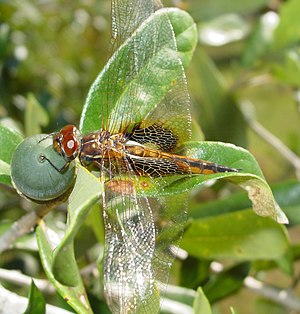Miathyria marcella
| Miathyria marcella | ||||||||||||
|---|---|---|---|---|---|---|---|---|---|---|---|---|

Miathyria marcella |
||||||||||||
| Systematics | ||||||||||||
|
||||||||||||
| Scientific name | ||||||||||||
| Miathyria marcella | ||||||||||||
| ( Sélys , 1857) |
Miathyria marcella is a species of dragonfly from the subfamily Pantalinae . It occurs in the south of the USA to southern Argentina . Thespecies is also representedon the West Indies .
features
Construction of the Imago
The animal reaches a length of 35 to 41 millimeters, of which 21 to 27 millimeters are on the abdomen . Young miathyria Marcella have a first brownish frons , which is changing the discolouring in a metallic blue or violet hue. The complex eyes are reddish brown. The thorax is brown with two lighter side stripes. As the males turn purple with age, these stripes become increasingly indistinct. The abdomen is yellowish orange with a black stripe down the center of the back. The hind wings are between 27 and 34 millimeters long and have a brown spot at the base. In the area of this spot, the wing veins are yellowish red. The rest of the wing is see-through. The animal also has seven anterodal veins in the front wing and four in the rear wing . The legs are dark brown.
Construction of the larva
The fully grown larva of M. marcella reaches a length between 16.5 and 17.5 millimeters. The abdomen accounts for about 9.5 millimeters of this. The width of the brownish abdomen is five millimeters. The wing sheath extends to the seventh segment and there are dorsal spines on segments four to eight . A tiny tick can also be seen on the third segment. Overall, the size of the spikes increases towards the rear. There are also lateral spines on the eighth and ninth segments . The posterior femur is 4.5 millimeters long. There are also two darker rings at the apex of the femora of each leg. The head is five millimeters wide and strongly rounded by the complex eyes located at the front corners. The labium has seven bristles laterally and on the mentum . There are also three to four smaller bristles on the mentum.
Similar species
Representatives of the genus Tramea in particular are very similar to M. marcella . But these can be distinguished by their larger size.
Descriptions
The species was first described in 1857 under the name Libellula marcella by Edmond de Sélys-Longchamps on the basis of a male from Brazil that has now disappeared . Hermann August Hagen provided a further description in 1861 based on a Cuban specimen under the name Tramea simplex . It wasn't until 1913 that Ris recognized the synonymy.
credentials
- ^ Carlos Esquivel - Libélulas de Mesoamérica y el caribe [p. 241], Herrara, Editorial INBio ISBN 9968-927-13-9
- ↑ a b http://odonatacentral.bfl.utexas.edu/fieldguide/species.asp?taxaid=299 ( page no longer available , search in web archives ) Info: The link was automatically marked as defective. Please check the link according to the instructions and then remove this notice. (July 1, 2007)
- ^ Carlos Esquivel - Libélulas de Mesoamérica y el caribe [p. 225], Herrara, Editorial INBio ISBN 9968-927-13-9
- ^ Westfall, Minter J. Jr. - The Nymph of Miathyria Marcella Selys (Odonata), Florida Entomologist, v. 36, n. 1, p. 21-25
- ^ Henrik Steinmann - World Catalog of Odonata (Volume II Anisoptera) [p. 551], de Gruyter, 1997, ISBN 3-11-014934-6
Web link
- Miathyria marcella inthe IUCN 2013 Red List of Threatened Species . Listed by: Paulson, DR, 2007. Retrieved March 3, 2014.